
How to Learn Data Structures
When you are learning how to code, you will inevitably come across data structures. Data structures define how data is controlled in a program. They will probably not come up every day. Nonetheless, data structures play a key role in computer science and coding.
In this guide, we are going to discuss what you need to learn about data structures and why you should learn about them. Then, we will show you different paths to acquire a solid understanding of this concept.
What You Need to Know About Data Structures
The data structures you need to know are clearly defined. When you look up specific data structures, you see they all follow the same rules. Implementations may vary between programming languages but each is based on a specific theory.
To help you better understand the concept, we have compiled a list of some essential data structures you need to know.
- Arrays: Arrays are lists of data. They can store different values like strings and other arrays. You can access each item in an array through a method called indexing.
- Queues: Queues operate on a first-in, first-out (FIFO) basis. This means that the first item you add to a queue will be the first one to leave. To visualize queues, think about a line in a supermarket or a coffee shop where the first customer in line is the first to leave.
- Stacks: Stacks use a last-in, first-out (LIFO) structure. The last item you added to the stack is the first one out. Imagine grading a pile of homework. The first assignment on top (the last one handed in) will be the first one marked.
- Linked Lists: A linked list is a list where items are not stored in order in memory. Instead, elements point to each other. These pointers define the order of items in the list.
These are five data structures you should learn. Once you understand these structures, you should also look into graphs, heaps, trees, and hash tables, which are commonly used in data science alongside the five mentioned above.
Skills Needed to Learn Data Structures
You should have a good understanding of computer science before you start working on learning data structures and algorithms, which are commonly taught at the same time. Such an understanding is necessary because a lot of data structure and algorithm work delves into computer science theory. Studying these concepts without a good theoretical foundation can be confusing.
Some programming experience will help too. This is because you will probably have to write a data structure in a programming language at some point after you have learned the structure itself. Indeed, data structures are not just theory: they apply directly to programming.
Why You Should Learn Data Structures
For the most part, you can get away with having very little knowledge of data structures. However, if you want to become a professional coder, there will come a point when you have to study them.
Knowing data structures and algorithms will help you write more efficient code as well as understand code that has already been written. For instance, you will know exactly what a linked list is, how it works, and why it is used. Otherwise, seeing a linked list may throw you off when trying to understanding a particular program.
How Long Does it Take to Learn Data Structures?
You should expect to spend between one and four weeks learning data structures. This assumes that you are interested in all the main data structures and that you study for at least an hour a day. If you want to learn algorithms too, you can expect to study for an additional month or so. But, everyone learns at different paces; you may be able to learn how to use algorithms and data structures in a shorter period of time.
Learning Data Structures: A Study Guide
How do you go about learning data structures? That is an excellent question. To help you learn data structures, we have prepared a list of top data structures courses and other resources.
Data Structures and Algorithms Nanodegree by Udacity

- Resource Type: Course
- Price: $399 per month
- Audience: Beginners to data structures. Knowledge of programming and algebra necessary
The Udacity Data Structures and Algorithms Nanodegree teaches you the basics of using and writing data structures as well as basic and more advanced algorithms. This course uses Python to implement the data structures and algorithms you learn.
Throughout the course, you will explore topics like recursion, open-ended problems that may require data structures for a solution, implementing brute-force and greedy algorithms, and more.
Data Structures and Algorithms by UC San Diego on Coursera
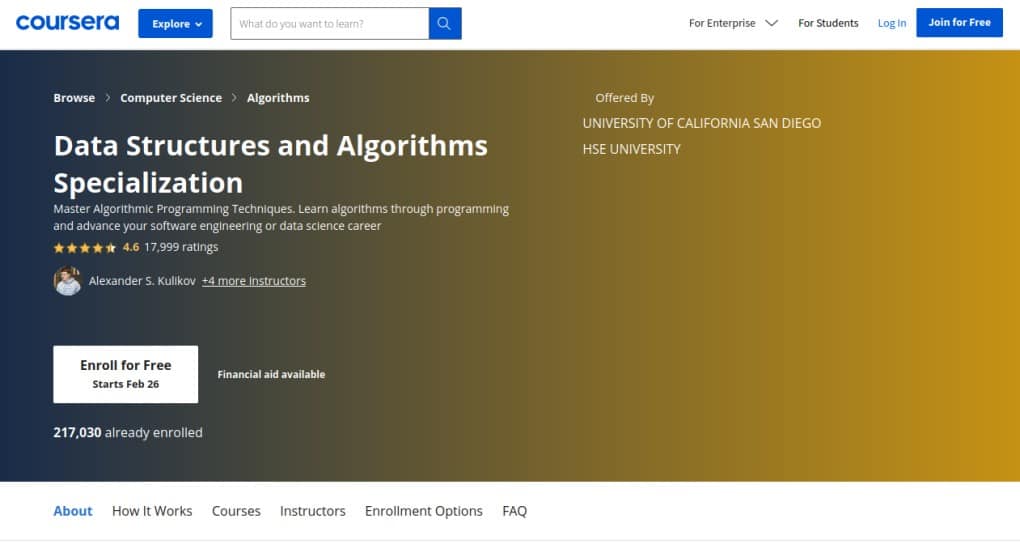
- Resource Type: Course
- Price: Free
- Audience: Intermediate
In this course, you will learn the theory behind basic and more advanced algorithms as well as common data structures. You will also learn how you can solve advanced problems using some of the tools you have learned.
This course, which requires basic knowledge of at least one programming language, offers two projects on which you can work. These projects will help you practice the theory you have learned in class. They will also help you build an understanding of how algorithms and data structures are used in the real world.
Easy to Advanced Data Structures
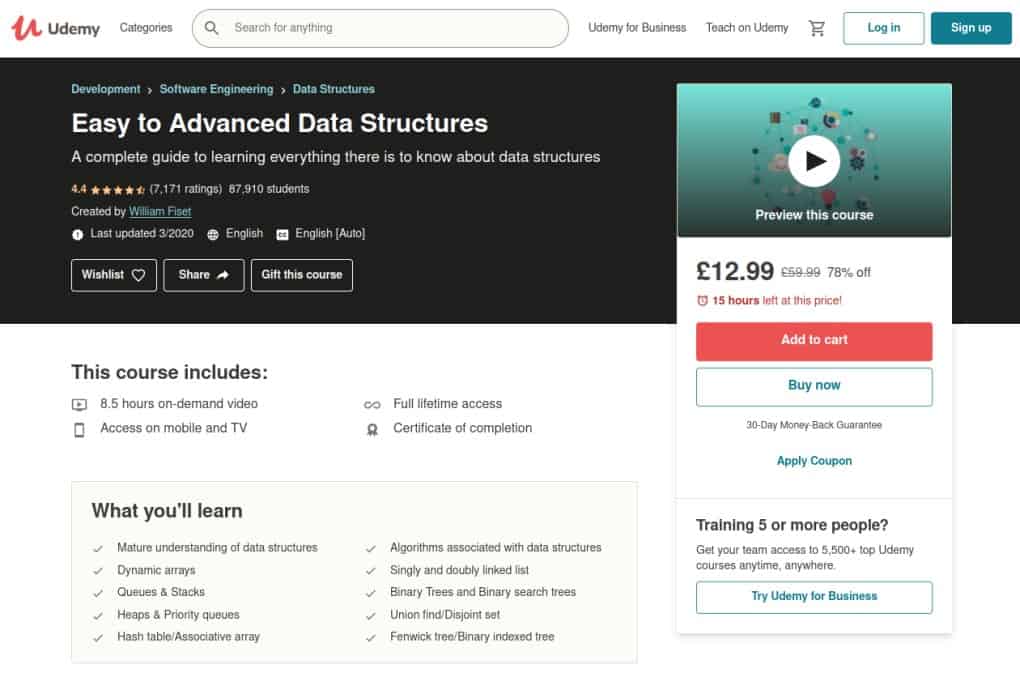
- Resource Type: Course
- Price: $83.50
- Audience: Beginner
Featuring eight-and-a-half hours of on-demand video, this Udemy course covers all of the basic data structures that you need to know. You will study topics like dynamic arrays, queues and stacks, heaps, hash tables, and more.
In this course, you will learn the theory you need to implement a data structure in a programming language. The course also comes with Java source code that you can refer to as you learn about data structures.
GeeksforGeeks Data Structures
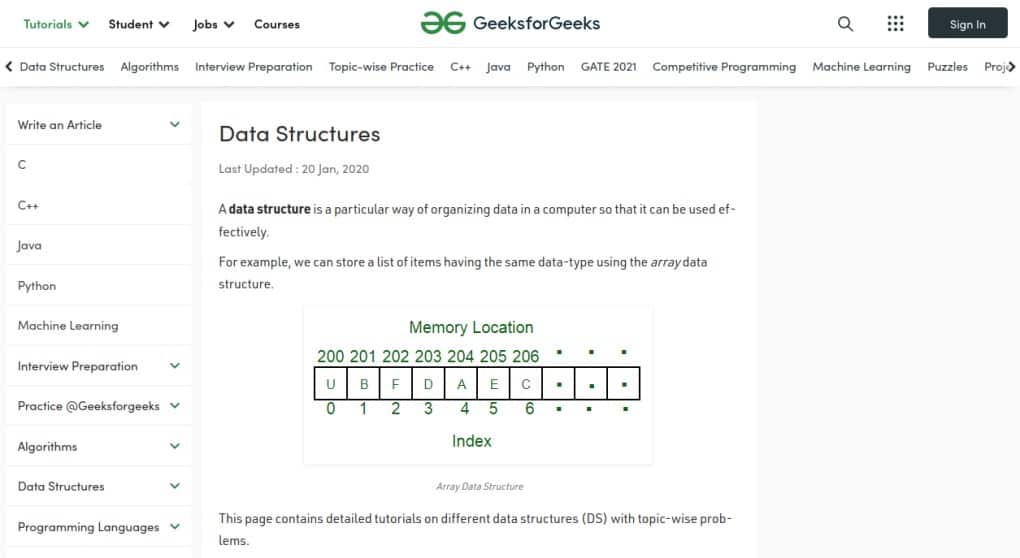
- Resource Type: Tutorials
- Price: Free
- Audience: (Beginner/intermediate/expert)
GeeksforGeeks has dozens of articles on data structures to help you as you study this conceept. Most articles feature code snippets to visualize how a data structure is implemented in code. There are also explanations to accompany each algorithm and walkthroughs on key topics.
Data Structures by freeCodeCamp
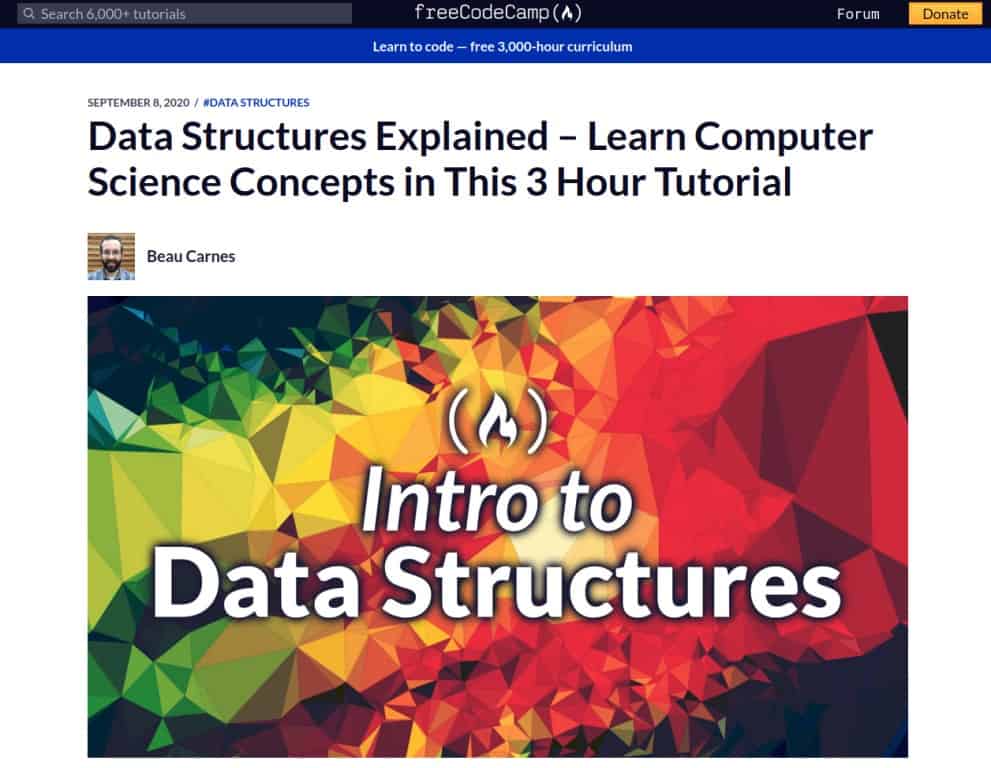
- Resource Type: Video
- Price: Free
- Audience: Beginner
For those who are already comfortable with the basics of data science and who want to learn about data structures, the Data Structures video by freeCodeCamp is worth a look. This video, which lasts three hours, covers queues, arrays, stacks, trees, and other data structures. You will learn the theory behind each structure and how they are used.
Master the Coding Interview: Data Structures + Algorithms on Udemy
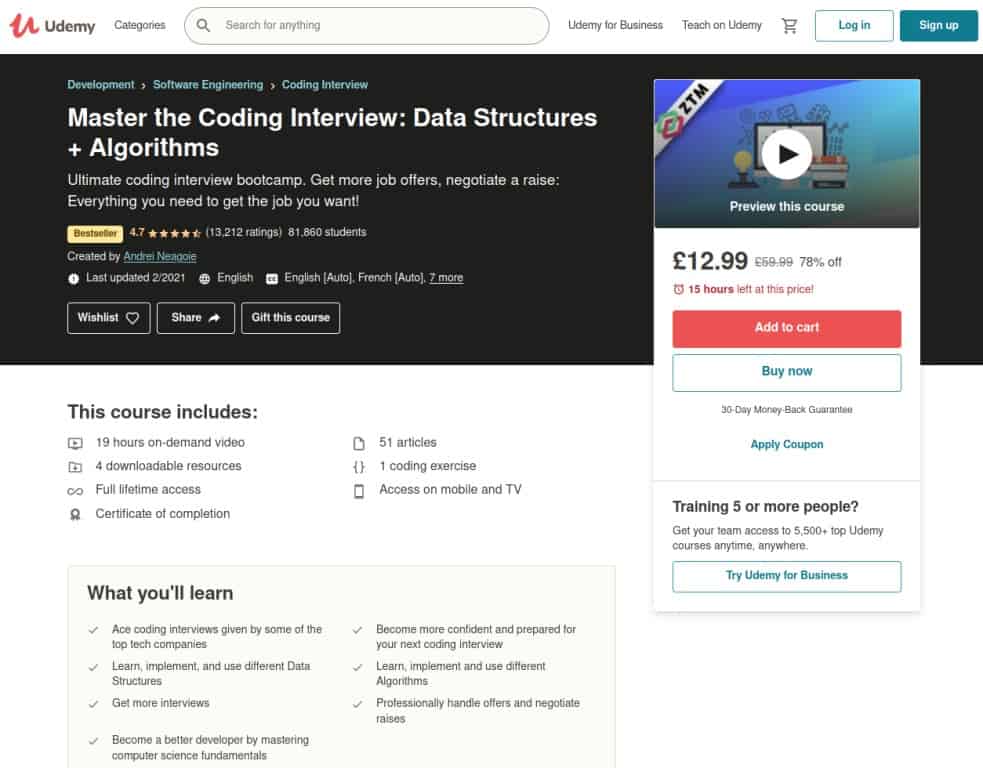
- Resource Type: Course
- Price: $18.10
- Audience: Beginner
This course, composed of 51 articles and 19 hours of video, will arm you with the knowledge you need to succeed in a technical interview. This course will teach you how to implement various data structures. You will also receive guidance on how to solve coding problems in an interview.
Communities for People Studying Data Structures
Communities are a good place to go if you have a question about programming. There are several communities that feature discussions on data structures. These discussions will help you overcome any challenges you are facing. You will also have the opportunity to meet new developers and expand your network.
Stack Overflow Computer Science Community
The Stack Overflow Computer Science thread features hundreds of discussions on computer science theory, many of which focus on data structures. In this community, you will be able to ask questions, receive answers, and view the answers to questions posted by other people. You will also find plenty of code snippets to assist you as you learn data structures.
Dev.to Data Structures
The Dev.to data structures community is a good place to go to share your data structures knowledge and learn from other people. Dev.to features a range of useful posts, including questions and examples. Topics covered include max heaps implemented in Go, using arrays in JavaScript, and Java LinkedLists.
How Hard Is it to Learn Data Structures?
With some knowledge of computer science, you should have no trouble learning the basic data structures. However, you may need to spend more time understanding the more advanced data structures. In any case, with the right dedication and time investment, you will be able to learn the theory behind the main data structures and how to implement them in code.
Will Learning Data Structures Help Me Find a Job?
Data structures are an essential topic in many technical job interviews, especially those related to data science and software engineering. In both of these fields, data structures are likely to come up frequently.
To help you understand how learning data structures could impact your career, we have put together a few figures on careers in data science and software engineering:
- Salaries: According to Glassdoor, the average data scientist earns $113,309 per year while the average software engineer brings in $92,046.
- Job Openings: On Glassdoor, there are 131,938 open software engineering jobs and 30,264 data scientist jobs.
- Industry Growth: The U.S. Bureau of Labor Statistics estimates jobs in software engineering will grow at a rate of 22% between 2019 and 2029. Data is not available specifically for data science jobs.
You could also apply data structures knowledge to a career in machine learning, deep learning, and artificial intelligence. All of these careers are well-paid and expected to play a major role in the global economy in the future.
Conclusion: Should You Learn Data Structures?
Knowing the theory of and how to implement data structures is incredibly valuable regardless of what programming career you pursue. Data structures are likely to come up in most software engineering and data science-related job interviews. In such discussions, you will be expected to clearly explain data structures and perhaps solve problems involving them.
Data structures may not be as widely used in web or mobile development. However, you may still encounter them, so knowing about data structures will set you in good stead. To sum up, data structures are widely used in tech jobs; knowing about them can only add value to your career in technology.


